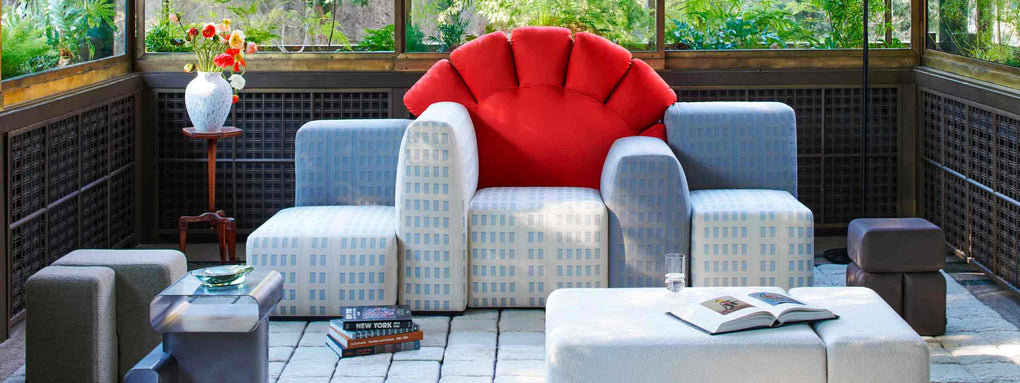#07 VENICE
THE BLOG - curated by Antonella Dedini
DESIGN ITALY IN THE WORLD
VENICE

The lagoon city of Venice is itself irrational but perfect. Balanced between the past and the contemporary, crystallized within a well-defined temporal and geographical perimeter, it plays a strategic role over time for connections, collaborations, and cultural synergies. Its remarkable capacity for survival and regeneration never ceases to amaze us. Despite the whims of the waters, the ebb and flow of tides, the disorderly flutter of pigeons, and the continuous influx of tourists armed with raincoats and rubber boots in all seasons, it stands eternal in unchanging light. It has always been the stage for a thousand cultural events: this year, the Architecture Biennale dominates the scene until November 26th, and now, until September 9th, it once again becomes the venue for one of the world's most famous events, the Film Festival, celebrating its 80th edition.
How to furnish a home in Venice?
ON THE ALTANA

The altana is a wooden rooftop terrace situated above the house. It is the necessary outpost for Venetians who use it to reach a piece of the sky and enjoy Venice's characteristic sunlight. Together with the tall chimneys, it is one of the architectural elements that define the city's skyline. It is customary to furnish it with seating and tables for aperitifs or evening meals and to savor breathtaking views.

White hibiscus and lemon trees, typical of the lagoon flora, grow in 3D-printed Moro ceramic pots, designed by Medaarch. Moro is part of the sixteenth-century Venetian tradition to ward off Saracen pirates; it is therefore a good luck charm and a symbol of well-being and wealth.
The dining or aperitif table is called Argo and is designed by Ludovica + Roberto Palomba for Talenti. It consists of large wooden slats and sturdy legs. The Venezia chair in polyethylene, designed by Favaretto & Partners for BBB Italia, resembles the typical wooden seats of Venetian bars and restaurants.
The lights on the altana should only provide atmosphere with indirect sources. The tall luminous vases by Christophe Pillet for Serralunga in polyethylene create a soft light that does not disturb the observation of the starry sky.
With humour, the Venezia rosette by Marianolight1898 recalls the lights of the illuminations during the annual Redentore Festival.
IN THE GRAND LIVING ROOM

Let's imagine the grand piano nobile of a palace on the Grand Canal... a dream for a few, but quite common even in Renaissance palaces that, as if frozen in time, miraculously rise along Venice's many waterways. The living area is a large, narrow, and long hall illuminated by significant ornate windows. In contrast, the furnishings are all contemporary, and the inclusion of famous design pieces such as the classic Chester armchairs by Poltrona Frau,  the Maralunga sofa by Vico Magistretti, and the Chaise Longue 4, Réglage Continu by Le Corbusier, Pierre Jeanneret, Charlotte Perriand for Cassina, creates a very modern atmosphere.
the Maralunga sofa by Vico Magistretti, and the Chaise Longue 4, Réglage Continu by Le Corbusier, Pierre Jeanneret, Charlotte Perriand for Cassina, creates a very modern atmosphere.
Murano, located in maritime Venice, is the island of blown glass, which has a long tradition of involving entire generations of master glassmakers. Murano glass is handcrafted and mouth-blown to forge extraordinary collections of vases and chandeliers like the Murano Glass Chandelier K1 by Karim Rashid for Purho, which elegantly dominates the space, as is tradition.
At the far end of the room, near the large windows, the Veliero bookcase by Franco Albini for Cassina, light and transparent, reminiscent of the masts and stays of an ancient boat passing on the canal.
The Tigram armchairs by Italo Pertichini for Adrenalina and the Mamy Blue pouf by Poltrona Frau play with the art of simple geometric composition and colours that emphasize their shapes, giving great prominence to the environment.
IN THE BEDROOM

The bedroom is decorated with the typical Venetian stucco work applied with a spatula to create a smooth yet three-dimensional effect. The bed, designed by interior designers Bernhardt&Valle for Arflex, is called Palazzo and features a movable headboard that serves as a "screen" to provide more privacy and comfort in a large space. It can be placed in the center of the room and is available in various sizes and upholstery options.

At the foot of the bed, there are two large poufs shaped like parcels designed by Mogg, containers that remind us of Venice's mercantile history and add a touch of humor to the master bedroom, making it more contemporary and light-hearted.
















